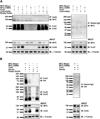Cardiomyocyte-specific overexpression of the ubiquitin ligase Wwp1 contributes to reduction in Connexin 43 and arrhythmogenesis
- PMID: 26386426
- PMCID: PMC4641030
- DOI: 10.1016/j.yjmcc.2015.09.004
Cardiomyocyte-specific overexpression of the ubiquitin ligase Wwp1 contributes to reduction in Connexin 43 and arrhythmogenesis
Abstract
Gap junctions (GJ) are intercellular channels composed of connexin subunits that play a critical role in a diverse number of cellular processes in all tissue types. In the heart, GJs mediate electrical coupling between cardiomyocytes and display mislocalization and/or downregulation in cardiac disease (a process known as GJ remodeling), producing an arrhythmogenic substrate. The main constituent of GJs in the ventricular myocardium is Connexin 43 (Cx43), an integral membrane protein that is rapidly turned over and shows decreased expression or function with age. We hypothesized that Wwp1, an ubiquitin ligase whose expression in known to increase in aging-related pathologies, may regulate Cx43 in vivo by targeting it for ubiquitylation and degradation and yield tissue-specific Cx43 loss of function phenotypes. When Wwp1 was globally overexpressed in mice under the control of a β-actin promoter, the highest induction of Wwp1 expression was observed in the heart which was associated with a 90% reduction in cardiac Cx43 protein levels, left ventricular hypertrophy (LVH), and the development of lethal ventricular arrhythmias around 8weeks of age. This phenotype was completely penetrant in two independent founder lines. Cardiomyocyte-specific overexpression of Wwp1 confirmed that this phenotype was cell autonomous and delineated Cx43-dependent and -independent roles for Wwp1 in arrhythmogenesis and LVH, respectively. Using a cell-based system, it was determined that Wwp1 co-immunoprecipitates with and ubiquitylates Cx43, causing a decrease in the steady state levels of Cx43 protein. These findings offer new mechanistic insights into the regulation of Cx43 which may be exploitable in various gap junctionopathies.
Keywords: Arrhythmogenesis; Connexin; Gap junction; Ubiquitin; Wwp1.
Copyright © 2015 Elsevier Ltd. All rights reserved.
Figures







References
-
- Beardslee MA, Laing JG, Beyer EC, Saffitz JE. Rapid turnover of connexin43 in the adult rat heart. Circulation research. 1998;83:629–635. - PubMed
-
- Darrow BJ, Laing JG, Lampe PD, Saffitz JE, Beyer EC. Expression of multiple connexins in cultured neonatal rat ventricular myocytes. Circulation research. 1995;76:381–387. - PubMed
Publication types
MeSH terms
Substances
Grants and funding
LinkOut - more resources
Full Text Sources
Other Literature Sources
Medical
Molecular Biology Databases
Miscellaneous

